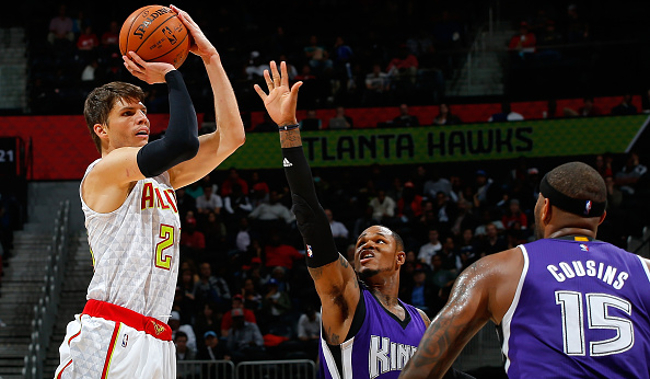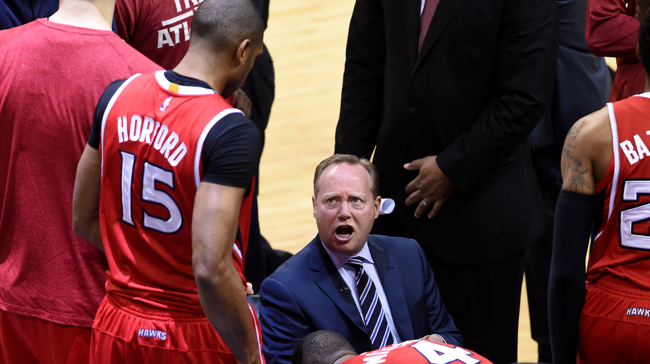Last season, the Atlanta Hawks were the unexpected darlings of the NBA. They won a franchise-best 60 games, had the Coach of the Year in Popovich protege Mike Budenholzer, and sent four players to the All-Star game, a feat only eight teams in league history have accomplished. They did all of this without boasting a single superstar on their roster, in no small part to a Spurs-like predilection for spacing and ball movement that Budenholzer picked up during his 17-year tenure as an assistant on San Antonio’s bench.
It’s highly possible that the Hawks surprised even themselves with their early-season success. They had been a good team in previous seasons and showed tremendous growth in several key areas, but they made such a stratospheric ascent in the 2014-15 season that it was difficult to process. The pinnacle of that was an undefeated January to kick off 2015, the first 17-0 month in NBA history.
But after the All-Star break, the once-majestically-soaring Hawks came crashing back down to Earth. Including the playoffs, they finished the season with a mediocre 25-19 record, which culminated with them being knocked out of the Eastern Conference Finals by the Cleveland Cavaliers in five games. And it’s difficult to pinpoint precisely what went wrong. According to SportsVU data, they executed just as well, if not better, than they had up to that point in the season, freeing up even more open looks at the basket.
Somewhat inexplicably, they just stopped making as many of those shots. And the only real accounting for that are the inescapable laws of probability. But also ill-timed injuries. And naturally-occurring shooting slumps. Okay, so maybe it wasn’t that big of a mystery. In the end, the Hawks were just like any other NBA team, subject to the same peaks and valleys that pepper the terrain of a grueling 82-game season.
It was easy to see their ouster in the Conference Finals as a disappointing conclusion to an otherwise Cinderella season. And their subsequent offseason wasn’t anything to write home about either. Losing DeMarre Carroll to Toronto in free agency was a considerable (if unavoidable) setback, in terms of both their perimeter defense and their three-point shooting. But the addition of Tiago Splitter as a backup center behind Al Horford was a solid acquisition given the price-tag, although injury woes have rendered him a nonentity of late (more on that later).
The start to their 2015-16 campaign hasn’t come with any of the magic that accompanied their blistering 43-11 start last season, despite winning eight of their first ten games, including seven-straight after their opening night loss to the Detroit Pistons. They essentially played .500 ball after that until another six-game win streak in mid-to-late December, which briefly catapulted them to the No. 2 spot in the Eastern Conference.
They’re currently 7-3 in their last 10 games, but after dropping three out of their last four — including two-consecutive losses to the Knicks — they’ve fallen back to fifth place in the East, where the rankings have been in perpetual flux as just three games separate teams two through five in the standings.
During their most recent win streak, three out of those six wins came against teams with losing records. In fact, a closer inspection of their win/loss column reveals an even more troubling trend: they’ve only beat one of the league’s true contenders so far this season, a 106-100 victory over the Oklahoma City Thunder on November 30. To make matters worse, their schedule hasn’t exactly been a gauntlet of the NBA’s elite.
So, what’s going right for the Hawks so far this season? At a glance, a lot more than you probably think. Despite Carroll’s absence, they’re still a top-ten defensive team (they’ve since slipped to No. 12 since this writing) and rank third overall in steals. They also boast the No. 7 offense in the NBA (104.5 points per 100 possessions) and, as a result, a top 10 overall net rating.
On paper, they still share the ball well, as evidenced by their No. 3 ranking in assist percentage (behind only the Golden State Warriors and San Antonio Spurs), which is buoyed by their top-five ranking in both true shooting (behind the Warriors, Spurs, and Thunder) and effective field goal percentage. Suffice it to say these numbers are all extremely promising.
They’ve upped the pace this year just a smidge (like the rest of the league), but they’ve never been particularly fast. (As an aside, the efficacy of pace in the so-called “pace-and-space” era of the modern NBA has been somewhat overinflated. Of the top ten fastest teams in the league so far this season, only two – the Thunder and Warriors – can be considered legitimate contenders. The Suns and Sixers, for example, also rank among the top ten in this category, while the Spurs and Cavs rank near the bottom.
And one of the primary focal points for the Hawks this season is the man who ultimately replaced Carroll in the lineup: the #BazedGod himself, Kent Bazemore. After nearly doubling his career average in playing time this season, the interminably and infectiously upbeat Bazemore is posting career highs in points, rebounds, assists, steals, and shooting percentages all across the board.
Going into Tuesday’s matchup against the Knicks, he averaged 55 percent shooting from deep in his three previous outings and proceeded to shoot 50 percent against New York. The only hitch is that he’s emphatically a catch-and-shoot threat from behind-the-arc. He shoots 50 percent when those shots are created for him, and that number plummets to 25 percent when he creates them for himself off the dribble. Thankfully for the Hawks, their spread-the-wealth offensive philosophy (in theory) means they don’t have to rely on players like Bazemore to create for themselves.
The question, then, circles back to his overall value, and this is where everything gets tricky given how difficult it’s been to accurately quantify. Going purely by his on/off numbers, Atlanta essentially breaks even. They score 102.8 points per 100 possessions and give up 102 when he’s on the court. It’s basically a wash. But as usual, those numbers don’t tell the whole story because on/off numbers alone leave out important variables like lineup configurations. For instance, when you sub in Dennis Schroder for Jeff Teague with the rest of the starters, their net rating balloons to plus-23.9.
Yet, the starting five with Bazemore remains in the red, and when you swap in Thabo Sefolosha for Baze, it jumps to plus-5.2. In other words, there’s a good reason why Bud has done so much dickeying around with his lineups and why that latter is the Hawks’ second-most used unit this season.

A lot of this stuff is counter-intuitive considering how well Bazemore has played individually. When you look at the game logs, he’s shot better than 50 percent from downtown in his last four contests, yet the Hawks have lost three of those games. By contrast, during the Hawks’ most recent six-game win streak, Baze shot 33 percent from three. His three-point shooting simply hasn’t translated into wins lately. For whatever reason, they’re empty stats.
At least some of Atlanta’s woes can be attributed to the (relative) decline of Kyle Korver this season. The Hawks’ resident sharpshooter has been practically unconscious from long-range for most of the last three-plus seasons, particularly last year when he shot himself right into the All-Star game as an injury reserve and finished the season averaging 49.2 percent from downtown (remarkably, that wasn’t even his career best, which came in 2009-10 when he shot 53.6 percent from deep for the season as a member of the Utah Jazz).
Here in 2015-16, however, the 34-year-old Korver is shooting threes at a pedestrian (by his own lofty standards) 36 percent clip. Despite logging more minutes, he’s also averaging his lowest points per game since the 2010-11 season. Regardless, the Hawks are still 6.4 points better when he’s on the floor, but it’s clear that his ungodly accuracy from outside has been a major factor in the Hawks’ success the past few years. Without it, they look like mere mortals this season.
Likewise, Paul Millsap, also known as the Hawks’ best all-around player, has also regressed in that department. After shooting better than 35 percent from three the past two seasons, he’s down to 28.9 percent so far. This despite him averaging nearly two more points per game. It’s been the dull consistency of Teague and Al Horford, two of the league’s most solid, least-spectacular players, who have keep the Hawks aloft.
Another key question for any serious contender is whether they have sufficient depth to spell their core unit over the course of a deep postseason run. Atlanta was pretty mediocre in that area last season, finishing 19th overall in bench scoring. They’re even worse in that category this year, which might be the only logical explanation for why Dennis Schroder logged two-consecutive “DNP’s – Coach’s Decision” recently.

At least that’s what Budenholzer would have the media believe when he cited player development as his rationale for curiously benching Schroder for two-straight games in favor of Shelvin Mack. Schroder hasn’t seen any significant dip in his productivity or efficiency this season, and according to Bud, hasn’t been exiled to his proverbial doghouse for any disciplinary reasons. It’s a head-scratcher, to say the least, but Schroder returned Tuesday night against New York and played well, although it ultimately didn’t make much of a difference.
In fact, their Tuesday night loss (their second-straight loss to the Knicks in three days) was a case study for everything that’s wrong with the Hawks this season, however nebulous: the lethargy on defense, the lack of rhythm on offense, and an alarming inability to knock downs shots with any kind of consistency.
One of the reasons Schroder played the final 20 minutes of that game is that Teague had failed to register an assist up to that point. Certainly, it’s the point guard’s responsibility to orchestrate the offense, but Atlanta as a whole settled for far too many long twos that came late in the shot clock as well as a number of one-and-done offensive possessions. They also just missed wide-open shots, except for Teague, who was 5-of-9 from the field, including 3-of-4 from downtown before he got yanked.
In short, things are complicated — bordering on confounding — for the Hawks, and there’s no easy solution in sight. It’s a Catch-22 right now: until they figure out their most effective rotations, they won’t be able to find any rhythm or consistency. There’s still time to accomplish that, but the clock is ticking, and their overall lack of urgency in all facets of the game doesn’t bode well for any championship aspirations they might still harbor.
Getting Splitter back after missing the last four games with a calf strain should help some. He’s missed a total of 13 games this season, and the Hawks have suffered without him. They’re 15-8 when he’s played this season and 6-7 without him. But if they’re looking to Splitter as the answer to all their problems, then they’re in bigger trouble than we thought.
*Statistical support for this article provided by NBA.com/stats and HoopStats.com.






